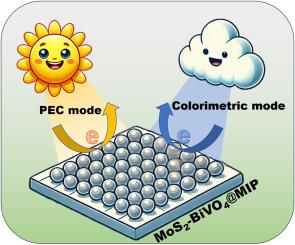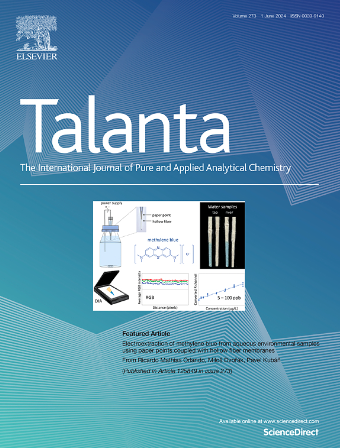双功能MoS2-BiVO4异质结促进光电化学和比色双模式唾液酸传感
IF 6.1
1区 化学
Q1 CHEMISTRY, ANALYTICAL
引用次数: 0
摘要
唾液酸(SA)是一种重要的生物标志物,在各种疾病的诊断和监测中起着关键作用。本文建立了一种结合光电化学(PEC)和比色检测方法的双模传感系统,用于血清样品中唾液酸的灵敏和选择性检测。该系统提供交叉验证,独立的信号读出,从而提高检测的准确性和可靠性。我们首次揭示了MoS2-BiVO4异质结的双重功能,它显著提高了PEC和过氧化物酶样纳米酶的活性。这种协同效应通过使用单个双功能指标而不是组合两个单独的指标,简化了双模传感系统的构建。采用模板策略合成了具有广泛界面接触的双功能MoS2-BiVO4异质结,并利用花状MoS2来引导BiVO4纳米颗粒的生长,从而增强了电荷分离和催化活性,超过了单个组分。为了确保选择性识别,进一步将唾液酸特异性分子印迹聚合物(MIP)沉积在MoS2-BiVO4异质结上,作为传感系统的识别元件。唾液酸的选择性结合导致PEC和比色信号的减少,形成双模式检测的基础。通过对制备和检测条件的优化,该传感系统具有良好的分析性能,线性浓度范围为1 × 10−11 M ~ 1 × 10−6 M,检出限为3.4 × 10−12 M。该传感系统成功应用于血清样品,双模检测结果相互验证,进一步证实了该双模传感系统的高精度和实用可靠性。本文章由计算机程序翻译,如有差异,请以英文原文为准。

Bifunctional MoS2-BiVO4 heterojunction boosts photoelectrochemical and colorimetric dual-mode sialic acid sensing
Sialic acid (SA), a vital biomarker, plays a key role in diagnosing and monitoring various diseases. Herein, a dual-mode sensing system integrating photoelectrochemical (PEC) and colorimetric detection approaches was developed for the sensitive and selective detection of sialic acid in serum samples. This system offers cross-validated, independent signal readouts, thereby enhancing detection accuracy and reliability. For the first time, we unveil the dual functionality of the MoS2-BiVO4 heterojunction, which significantly boosts both PEC and peroxidase-like nanozyme activities. This synergistic effect simplifies the construction of a dual-mode sensing system by utilizing a single bifunctional indicator rather than combining two separate indicators. A dual-functional MoS2-BiVO4 heterojunction with extensive interfacial contact was synthesized via a templating strategy using flower-like MoS2 to guide the growth of BiVO4 nanoparticles, resulting in enhanced charge separation and catalytic activity surpassing those of the individual components. To ensure selective recognition, a sialic acid-specific molecularly imprinted polymer (MIP) was further deposited on the MoS2-BiVO4 heterojunction, serving as the recognition element of the sensing system. The selective binding of sialic acid led to a decrease in both PEC and colorimetric signals, forming the basis for dual-mode detection. After optimizing preparation and detection conditions, the sensing system demonstrated excellent analytical performance, with a broad linear concentration range from 1 × 10−11 M to 1 × 10−6 M and a low detection limit of 3.4 × 10−12 M. Its successful application to serum samples, with mutually validated dual-mode detection results, further confirmed the high accuracy and practical reliability of this dual-mode sensing system.
求助全文
通过发布文献求助,成功后即可免费获取论文全文。
去求助
来源期刊

Talanta
化学-分析化学
CiteScore
12.30
自引率
4.90%
发文量
861
审稿时长
29 days
期刊介绍:
Talanta provides a forum for the publication of original research papers, short communications, and critical reviews in all branches of pure and applied analytical chemistry. Papers are evaluated based on established guidelines, including the fundamental nature of the study, scientific novelty, substantial improvement or advantage over existing technology or methods, and demonstrated analytical applicability. Original research papers on fundamental studies, and on novel sensor and instrumentation developments, are encouraged. Novel or improved applications in areas such as clinical and biological chemistry, environmental analysis, geochemistry, materials science and engineering, and analytical platforms for omics development are welcome.
Analytical performance of methods should be determined, including interference and matrix effects, and methods should be validated by comparison with a standard method, or analysis of a certified reference material. Simple spiking recoveries may not be sufficient. The developed method should especially comprise information on selectivity, sensitivity, detection limits, accuracy, and reliability. However, applying official validation or robustness studies to a routine method or technique does not necessarily constitute novelty. Proper statistical treatment of the data should be provided. Relevant literature should be cited, including related publications by the authors, and authors should discuss how their proposed methodology compares with previously reported methods.
 求助内容:
求助内容: 应助结果提醒方式:
应助结果提醒方式:


